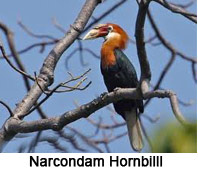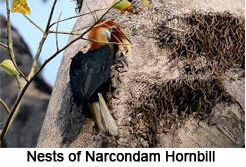 Narcondam Hornbill is an Indian bird that bears a scientific name "Rhyticeros narcondami" has distinct features. It belongs to the Bucerotidae family.
Narcondam Hornbill is an Indian bird that bears a scientific name "Rhyticeros narcondami" has distinct features. It belongs to the Bucerotidae family.
Behaviour of Narcondam Hornbill
Narcondam Hornbill is endemic to the Indian island of Narcondam in the Andamans. Males and females have a distinct plumage. Narcondom hornbill has the smallest home range out of all the species of Asian hornbills.
Structure of Narcondam Hornbill
Narcondam Hornbill is a small hornbill at 66 cm (26 in) long. The sexes differ in plumage. The male has a rufous head and neck, black body and upper parts glossed with green. Females are all black. There is a bluish white neck patch and the tail is white in both sexes. Both sexes have a bill with a few folds on the upper side towards the base of the upper mandible. The skin around the eye is bluish. The iris of the male is orange red while the female has an olive brown with a pale yellow ring. The bill is waxy and the furrows of the casque are brownish. The bill is pinkish towards the base. The legs are black and the sole is yellow.
Diet of Narcondam Hornbill
The nine species of fruits have been explicitly recorded in the diet of Narcondam hornbill. Narcondam Hornbill also consumes invertebrates and occasionally feed on small reptiles. They sometimes mob white-bellied sea eagles that fly too close. Being predominantly fruit eaters, they play an important role in the seed dispersal of figs and other plant species. Figs are important in the ecology of many other insular hornbill species and are major factors determining the distribution patterns of hornbills in forests.
 Breeding Season of Narcondam Hornbill
Breeding Season of Narcondam Hornbill
The breeding period of Narcondam Hornbill spans at least from February until April. The species nests in holes on the trunk or broken branches of large trees. The female remains concealed in the nest-cavity for the duration of egg-laying and chick-rearing. At this time, the female sheds her flight feathers and hence cannot fly. The male provides food for the female and chicks
Habitat of Narcondam Hornbill
Narcondam Hornbill is a resident of fairly open mixed forest that stretches over most of the island from sea level to about 700m.
Population of Narcondam Hornbill
The island of Narcondam has in the past been largely unpopulated. From there, the bird has been named as Narcondam Hornbill.



















